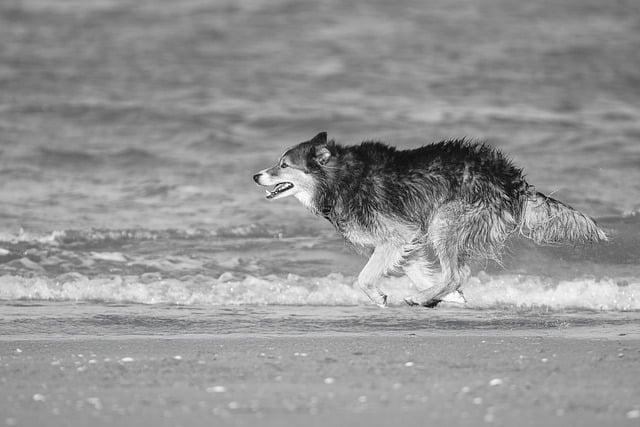Imagine coming home to find your beloved dog trembling in the corner, tail tucked tightly between its legs. This is more than just a fleeting moment; it’s a sign of anxiety that many pet owners overlook. Signs like excessive barking, destructive behavior, or even hiding can indicate your furry friend is struggling. Understanding these signals is crucial. By recognizing the signs of dog anxiety, you can take proactive steps to create a calmer environment, ensuring your pet feels safe and loved. Don’t wait—your dog’s well-being depends on it.
Contents
- Understanding the Behavioral Indicators of Dog Anxiety
- Recognizing Physical Symptoms That Signal Distress in Dogs
- Exploring Environmental Triggers That Contribute to Canine Anxiety
- Effective Strategies for Alleviating Anxiety in Your Dog
- Q&A
Understanding the Behavioral Indicators of Dog Anxiety
Recognizing the signs of anxiety in dogs is crucial for their well-being and your peace of mind. Dogs, much like humans, can experience a range of emotions, and anxiety can manifest in various ways. Understanding these behavioral indicators can help you identify when your furry friend is feeling stressed or overwhelmed. By being observant, you can take proactive steps to alleviate their discomfort.
One of the most common signs of anxiety is **excessive barking or whining**. If your dog suddenly becomes vocal when they are usually quiet, it may indicate that they are feeling anxious. Additionally, **destructive behavior**, such as chewing furniture or digging, can be a cry for help. This behavior often stems from pent-up energy or frustration, signaling that your dog needs support and reassurance.
Another indicator to watch for is **changes in body language**. A dog that is anxious may exhibit signs such as a tucked tail, flattened ears, or a lowered head. They may also avoid eye contact or try to hide in corners or under furniture. These physical cues are essential in understanding your dog’s emotional state and can guide you in providing the necessary comfort and care.
Lastly, **changes in appetite or sleep patterns** can also signal anxiety. A dog that suddenly refuses to eat or shows signs of restlessness at night may be experiencing stress. Monitoring these changes can help you identify triggers and implement strategies to create a more calming environment for your pet. By being attentive to these signs, you can foster a supportive atmosphere that promotes your dog’s mental health and overall happiness.
Recognizing Physical Symptoms That Signal Distress in Dogs
Understanding your dog’s physical symptoms is crucial in identifying their emotional state. Dogs, much like humans, express their feelings through their bodies. When a dog is experiencing anxiety or distress, certain physical signs may become apparent. These signs can range from subtle changes in behavior to more pronounced physical reactions that warrant immediate attention.
Some common indicators of distress include:
- Excessive panting: If your dog is panting heavily without any physical exertion, it could be a sign of anxiety.
- Trembling or shaking: Shivering can indicate fear or discomfort, especially in situations that are new or overwhelming.
- Changes in posture: A dog that is anxious may exhibit a lowered body posture, cowering, or even attempting to hide.
- Excessive drooling: While some drooling is normal, an increase in saliva production can signal distress.
Additionally, pay attention to your dog’s eyes and ears. A dog that is feeling anxious may have wide, dilated pupils and ears that are pinned back against their head. These physical cues are often accompanied by a lack of focus or an inability to respond to commands, which can be alarming for pet owners. Recognizing these signs early can help you intervene and provide the necessary comfort and support your dog needs.
Another important aspect to consider is changes in your dog’s appetite or sleep patterns. A dog that is feeling anxious may refuse to eat or show a marked decrease in their usual energy levels. Conversely, some dogs may overeat as a coping mechanism. Monitoring these behaviors can provide valuable insights into your dog’s emotional well-being. By being vigilant and responsive to these physical symptoms, you can create a more supportive environment that fosters your dog’s mental health.
Exploring Environmental Triggers That Contribute to Canine Anxiety
Understanding the environmental factors that can lead to anxiety in dogs is crucial for pet owners seeking to create a calm and supportive atmosphere for their furry companions. Various triggers in a dog’s surroundings can significantly impact their emotional well-being. By identifying these factors, you can take proactive steps to mitigate their effects and promote a sense of security for your pet.
Common environmental triggers include:
- Noise Sensitivity: Loud sounds such as thunderstorms, fireworks, or even construction work can cause distress in dogs. Many pets have heightened sensitivity to sudden or loud noises, leading to anxiety and fear.
- Changes in Routine: Dogs thrive on consistency. Any disruption in their daily schedule, such as changes in feeding times, walks, or family dynamics, can lead to feelings of insecurity and anxiety.
- New Environments: Introducing your dog to unfamiliar places or situations, like moving to a new home or visiting crowded areas, can overwhelm them. The lack of familiarity can trigger stress responses.
- Social Interactions: Not all dogs are naturally sociable. Encounters with unfamiliar people or other animals can provoke anxiety, especially if they have had negative experiences in the past.
Additionally, the physical environment plays a significant role in a dog’s mental state. A chaotic or cluttered home can contribute to feelings of unease. Dogs are sensitive to their surroundings, and a space that lacks tranquility may exacerbate anxiety symptoms. Ensuring a designated safe space for your dog, free from distractions and disturbances, can help them feel more secure.
Moreover, the presence of other pets can also influence a dog’s anxiety levels. If there is tension or aggression among household animals, it can create a stressful environment for all involved. Monitoring interactions and providing separate spaces for pets when necessary can help reduce anxiety and foster a more harmonious living situation.
Effective Strategies for Alleviating Anxiety in Your Dog
Understanding how to effectively alleviate anxiety in your dog is crucial for their overall well-being. One of the first steps is to create a calm environment. This can be achieved by establishing a designated safe space where your dog can retreat when feeling overwhelmed. Use comfortable bedding, familiar toys, and perhaps a piece of your clothing to provide a sense of security. Dimming the lights and minimizing noise can also help create a soothing atmosphere.
Incorporating regular exercise into your dog’s routine is another powerful strategy. Physical activity not only helps to burn off excess energy but also releases endorphins that can improve mood. Activities such as daily walks, playtime in the yard, or engaging in interactive games can significantly reduce anxiety levels. Tailoring the intensity and duration of exercise to your dog’s age and breed will ensure they receive the right amount of stimulation.
Consider utilizing behavioral training techniques to help your dog cope with anxiety triggers. Positive reinforcement methods, such as rewarding calm behavior with treats or praise, can encourage your dog to respond more favorably to stressful situations. Gradual desensitization to specific triggers, such as loud noises or unfamiliar environments, can also be beneficial. This process involves slowly exposing your dog to the anxiety-inducing stimulus in a controlled manner, allowing them to build confidence over time.
Lastly, exploring natural remedies and professional interventions can provide additional support. Products such as calming collars, pheromone diffusers, or herbal supplements may help ease anxiety symptoms. In more severe cases, consulting with a veterinarian or a certified animal behaviorist can lead to tailored treatment plans, which may include medication or specialized training programs. By taking a comprehensive approach, you can significantly improve your dog’s quality of life and help them feel more secure in their surroundings.
Q&A
-
What are the physical signs of dog anxiety?
Dogs often exhibit physical signs when they are anxious. Look for:
- Excessive panting
- Trembling or shaking
- Restlessness or pacing
- Hiding or seeking comfort
-
How can I tell if my dog is anxious during storms or loud noises?
Many dogs show heightened anxiety during storms or loud noises. Signs include:
- Whining or barking excessively
- Clinging to you or other pets
- Trying to escape or hide
- Destructive behavior, such as chewing furniture
-
Are there behavioral signs that indicate my dog is anxious?
Yes, behavioral changes can be a clear indicator of anxiety. Watch for:
- Increased aggression or irritability
- Loss of interest in activities or toys
- Excessive barking or howling
- Changes in eating or sleeping patterns
-
What should I do if I suspect my dog is anxious?
If you notice signs of anxiety, it’s crucial to take action. Consider:
- Consulting a veterinarian for advice
- Implementing a consistent routine
- Using calming products, such as anxiety wraps or pheromone diffusers
- Engaging in regular exercise and mental stimulation
recognizing the signs of dog anxiety is crucial for ensuring your pet’s well-being. By being attentive and proactive, you can create a supportive environment that fosters their happiness and health. Don’t wait—take action today for a calmer, more content companion.

大家好,我是彼得潘,專業的手法身體治療師。我喜歡探索和研究各種主題,並透過與人工智慧的合作分享專業、實用、有趣的文章。我們定期進行人工審核,以確保內容的準確性。如果您發現文章中有任何不準確的地方,請隨時與我們聯繫,我們會及時糾正。您可以透過 [email protected] 與我們聯繫。



